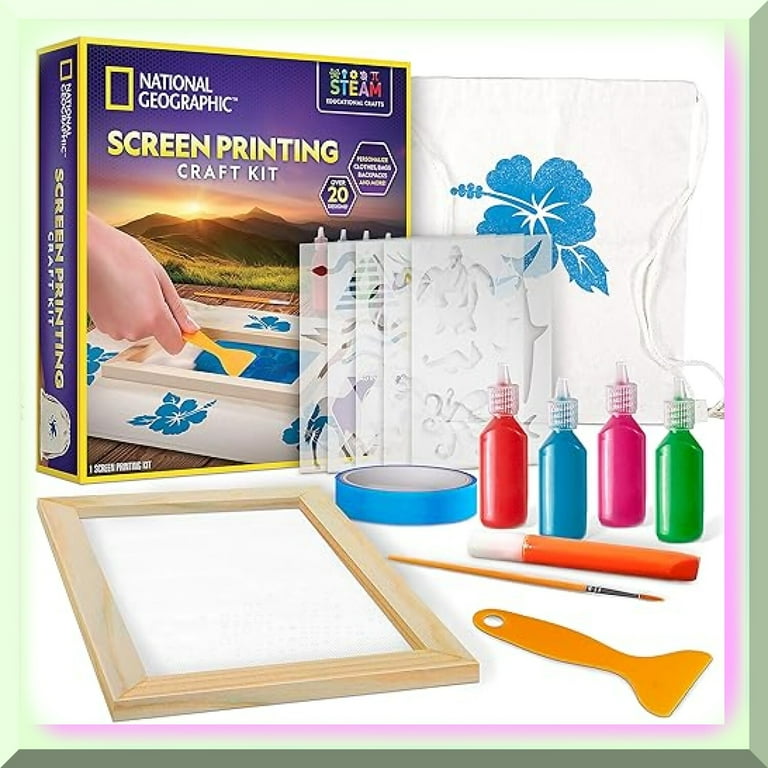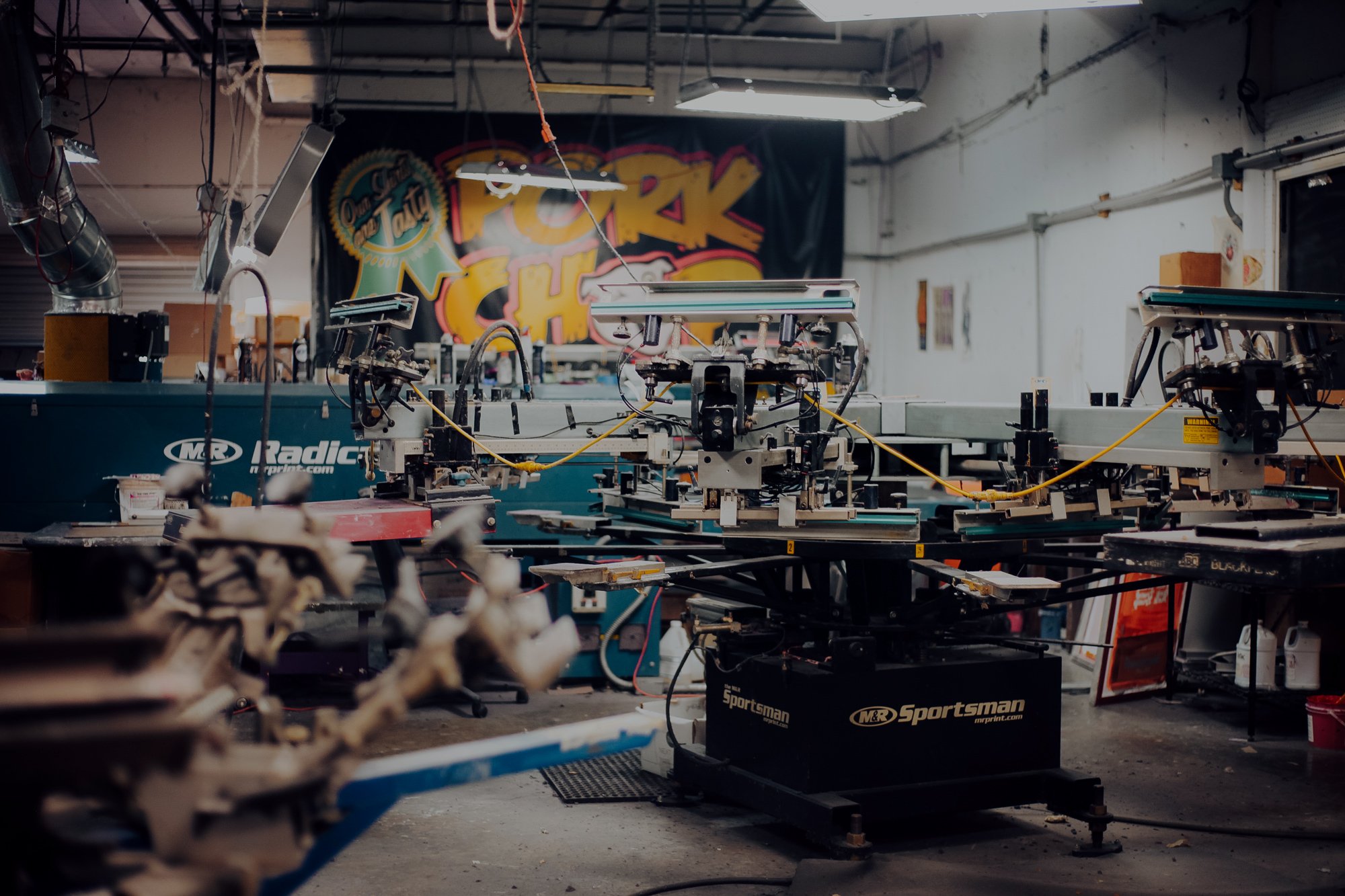Affordable Custom Screen Printing Services for Small Businesses
Affordable Custom Screen Printing Services for Small Businesses
Blog Article
Display Printing Uncovered: Whatever You Need to Understand About T-Shirt and Garment Printing Techniques
If you've ever asked yourself just how those lively layouts end up on your favorite tees, you're in the appropriate area. Display printing is a remarkable method that incorporates art with method, offering countless possibilities for creativity. Understanding the fundamentals, from equipment to ink selections, can significantly affect your outcomes. Prepared to discover the necessary components that make display printing an art kind? Let's discover the details that can elevate your tasks.
The Basics of Screen Printing: Just How It Works
When you plunge right into screen printing, you'll uncover it's both a science and an art. At its core, screen printing involves creating a pattern, or screen, that enables ink to travel through just in details locations (screen printing kit). You begin by picking your design and preparing your screen with a light-sensitive solution. As soon as you expose this solution to light, it solidifies, leaving your layout as an adverse space.
Position the display over the material, after that use a squeegee to press ink through the screen onto the garment. Each action is necessary, and grasping them will certainly raise your display printing skills, transforming simple garments into distinct, meaningful pieces.
Kinds Of Display Printing Techniques
Once you understand the fundamentals of screen printing, it's time to explore the different techniques that can elevate your layouts. One prominent approach is standard screen printing, where ink is pushed with a stenciled display. This technique is wonderful for vibrant, dynamic colors. There's water-based ink printing, which uses a softer feeling and is environment-friendly, but it needs a different method to treating.
If you're intending for fine details, think about discharge printing. This method eliminates dye from the material, leaving a soft, classic appearance. An additional choice is plastisol printing, understood for its sturdiness and vivid colors, making it a favorite for numerous brands. Experiment with halftone printing to produce slope results and complex layouts. Each technique has its one-of-a-kind appeal, so don't be reluctant to attempt them bent on find what suits your style best!
Crucial Tools for Screen Printing
To accomplish magnificent outcomes in display printing, having the right tools is basic. You'll require a sturdy screen printing framework, which holds the mesh that transfers your style onto the garment. Next, invest in top quality squeegees; these are important for applying ink uniformly across the screen.
Picking the Right Inks and Products
When selecting inks and products for screen printing, you need to consider the kind of ink that functions ideal for your task. Assume concerning material compatibility to guarantee your designs look last and great lengthy. Additionally, discover green ink alternatives to make your printing procedure much more lasting.
Kinds Of Display Inks
Choosing the ideal screen ink is vital for accomplishing dynamic, long lasting prints that satisfy your task's needs. There are a number of types of display inks to examine. Specialty inks, such as glow-in-the-dark or metal, can add special results to your designs.

Fabric Compatibility Considerations
Comprehending textile compatibility is essential for attaining top notch screen prints, specifically because different products react distinctly to various inks. Constantly examine your inks on sample textile to guarantee they stick effectively and preserve color stability. Additionally, keep in mind that fabric weight and appearance can affect the final end result, so selecting the right ink and product combination is crucial for your task's success.
Eco-Friendly Ink Options
Eco-friendly inks are ending up being a prominent selection for screen printers who intend to minimize their ecological effect while preserving high quality. When choosing inks, take into consideration water-based inks, which are less damaging and much easier to clean up compared to standard solvents. These inks bond well with materials, delivering vibrant results without poisonous chemicals. You could additionally explore eco-solvent inks that use fewer unpredictable click this organic substances (VOCs), making them a safer choice for both your wellness and the world.
In addition, look for inks made from renewable resources, such as soy or vegetable-based alternatives. By choosing the ideal inks and materials, you'll not only create spectacular styles yet additionally add to a much more sustainable printing procedure. Make the button, and your prints will reflect your dedication to the setting!
Preparing Your Design for Screen Printing

Submit Format Demands
To ensure your layout looks sharp and vibrant on fabric, you'll need to pay close attention to file format demands for screen printing. Make certain your layout has a clear history to prevent unwanted white edges on your prints. Keep color modes in mind; CMYK is standard for screen printing, so convert your RGB designs accordingly.
Color Splitting Up Methods
Color separation is a vital step in preparing your layout for screen printing, and understanding it can greatly boost your print high quality. You'll require to damage your layout into private colors, as each color requires a separate screen throughout printing. This accuracy not just guarantees exact shade representation however additionally simplifies the printing procedure.
Resolution and Size
Attaining the very best cause display printing begins with ensuring your style has the best resolution and dimension. Preferably, your art work must be at least 300 DPI (dots per inch) for sharp, clear prints. If you make use of reduced resolution, your end product could look pixelated and amateur.
When it involves size, think about the dimensions of your print location. Design your artwork to match the final print dimension, ideally developing it in the real measurements you'll be publishing. This method, you'll prevent any unexpected scaling issues.
Constantly examine your style in both vector and raster layouts. Vector graphics can be scaled without losing high quality, making them suitable for display printing. Preparing correctly will assure your layout looks fantastic on every garment!
Step-by-Step Display Printing Refine
Screen printing is a vibrant process that allows you to create lively styles on different surface areas. To get started, you'll need a screen, emulsion, and your picked ink.
After cleaning out the unexposed emulsion, your display is prepared. Establish it up on your printing surface area and straighten your garment underneath it. Pour ink onto the display and make use of a squeegee to push the ink with the stencil onto the fabric. Raise the screen meticulously and allow the print dry. Lastly, cure the ink utilizing warm to assure resilience. That's it! You've successfully screen published your layout.
Tips for Successful Display Printing Projects
While you're diving into your screen printing tasks, keep in mind that preparation is essential to success. Start by collecting all your materials-- inks, displays, mops, and garments. A clean workspace assists avoid undesirable errors, so tidy up prior to you start.
Next, verify your art YOURURL.com work is high-resolution and properly sized for your garment. Evaluate your display for appropriate exposure and clean it completely to prevent smudges. When mixing your inks, adhere to the maker's standards to accomplish the ideal uniformity.
During printing, apply even stress with your squeegee for consistent outcomes. Don't hurry; take your time to confirm each print fulfills your standards. After printing, allow your garments completely dry entirely before managing or packaging them.
Finally, constantly maintain an example of your work for future referral. In this manner, you can assess your progress and boost your strategies gradually. Satisfied printing!

Regularly Asked Questions
How much time Does It Require To Establish up a Screen Printing Job?
Establishing a display printing work normally takes around half an hour to an hour. You'll prepare the screens, mix inks, and change the press. The moment varies based on complexity and experience, so stay organized!
Can I Print on Various Fabric Enters Making Use Of the Very Same Technique?
Yes, you can publish on various material types making use of the exact same method, however you'll require to readjust your setups and inks. Some textiles take in ink differently, so exploring warranties the most effective outcomes for each and every product.
What Are Usual Errors to Avoid in Screen Printing?
When screen printing, prevent common blunders like utilizing the incorrect ink, neglecting correct exposure times, or missing pre-press checks. Always check your setup and keep tidy screens to ensure high quality outcomes each time.
Exactly How Can I Appropriately Tidy and Maintain My Display Printing Tools?
To properly tidy and preserve your screen printing equipment, you need to consistently clean screens with suitable solvents, inspect mops for wear, and guarantee all tools are kept completely dry and dust-free. Consistency improves and avoids pricey repairs efficiency.
Is Display Printing Eco-friendly Contrasted to Various Other Techniques?
Screen printing can be extra eco-friendly than various other methods, particularly if you make use of water-based inks and eco-conscious materials. By selecting lasting materials and methods, you decrease waste and minimize your effect on the earth.
Screen Printing Uncovered: Every Little Thing You Required to Know About Tee and Garment Printing Strategies
At its core, display printing entails producing a pattern, or screen, that permits ink to pass with only in details areas. Setting the screen over the material, then make use of a squeegee to press ink with the display onto the garment. One popular technique is typical screen printing, where ink is pressed through a stenciled screen.When selecting inks and materials for display printing, you need to take into account the type of ink that functions finest for your job.
Report this page